
Introduction: Are You Choosing the Correct Approach to Networking?
Without even recognizing it, are you compromising network performance?
Are you oblivious to traffic problems or security threats because your company network is not visible or controlled?
What if you could upgrade your network by only selecting the appropriate switch instead of employing an IT staff?
Whether you’re running a growing business, a busy café, or a smart home, the functionality of your local network may make or break productivity in today’s hyperconnected world. However, a crucial choice that many people ignore is whether to utilize a managed or unmanaged switch.
Control, safeguards, and scalability are becoming more important considerations when deciding between managed and unmanaged switches than pricing.
In order to assist you in selecting the best switch for 2025 and beyond, this article breaks out the distinctions between managed and unmanaged switches using case studies and real-world examples. The information that follows might help you avoid expensive network errors, regardless of your preference for simplicity or enterprise-level management.
Let’s get started and discover what your network actually needs.
A Network Switch: What Is It?
A network switch is a device that joins devices (such as servers, printers, and PCs) in a local area network (LAN) and forwards data to the target device using packet switching. Consider it your network’s traffic controller.
Two main categories of switches exist:
- Unmanaged switches are somewhat “plug-and-play” gadgets that don’t need any configuration.
- Managed switches provide complete visibility, control, and configuration choices.
- Unmanaged Switches: Cost-effective and Easy to Use
The entry-level productive machines of the networking industry are unmanaged switches. They offer basic network access without any requirement for the configuration or management and are designed to be easy to use, economical, and efficient.
The Essential Elements of Unmanaged Switches
- Plug-and-play ease of use
No configuration or setup is necessary. Simply connect your Ethernet wires and get started. For users without any IT experience, these switches are perfect.
- Auto-Bargaining
Automatically chooses for connected devices the best speed (10, 100, or 1000 Mbps) and duplex choice (full or half). Performance is optimized without the need for human input.
- Unchangeable Functionality
The feature set of unmanaged switches is fixed. Prioritizing traffic, dividing up users, or controlling ports are all impossible.
- Low Maintenance
There is no requirement for or availability of firmware upgrades or monitoring tools. With no administrative supervision, these switches operate silently in the background.
- Simple LED Indicators
Simple feedback, including link/activity status and port speed, is provided via the LED lights on the ports to verify basic functionality.
- Economical
Depending on the brand, number of ports, and speed (fast Ethernet vs. gigabit), prices can range from $20 to $100. Ideal for purchasers on a tight budget.
Common Use Cases
- Home offices:
Where remote workers or freelancers need to connect a NAS disk, printer, VoIP phone, and laptop.
- Little Retail Stores
For simplicity, an unmanaged switch can be used in a café with a guest Wi-Fi network, security camera, and point-of-sale system.
- Short-Term Networks
For quick, disposable networking, unmanaged switches are frequently used at events, trade exhibits, and pop-ups.
Real-World Example: Toronto Freelance Designer

Problem:
In order to mirror her screen, a freelance graphic designer wanted to link her workstation, printer, backup NAS, and smart TV.
Solution:
The TP-Link TL-SG108 8-Port Gigabit Unmanaged Switch was her choice for a solution. After connecting her gadgets, she was operational in a matter of minutes.
Benefits:
- No technical configuration
- Under $30
- Fanless, silent operation
- Two years of usage with no downtime
Restrictions:
- Absence of security measures: Anyone can connect to the network by plugging into a port.
- Absence of traffic control: There is no way to give video calls priority over downloads since all data is handled equally.
- Not Scalable: Does not provide link aggregation or VLANs for growing networks.
- Absence of troubleshooting tools: There is no method to pinpoint errors or assess performance when problems occur.
Summary:
In a nutshell unmanaged switches excel in terms of usability, price, and simplicity. However, they soon fall short as your network expands or security becomes an issue. Consider them the perfect instrument for simple, low-complexity, small-scale settings.
- Managed Switches: Performance, Security, and Control
The design of managed switches prioritizes network intelligence, control, and customization. They provide network managers the authority to adjust traffic flow, put security rules into place, keep an eye on performance, and grow infrastructure as required.
Important Characteristics of Managed Switches
- Vlan Support
Traffic between departments, visitors, or device types can be isolated with VLAN support (virtual LANs). VLANs decrease broadcast domains, which enhances security and performance.
2. Service Quality (QoS)
Give mission-critical traffic, such as ERP systems, VoIP, and video conferencing, priority. Make sure everything runs well, especially when there is a lot of traffic.
3. Monitoring and SNMP
Real-time performance monitoring, diagnostics, and alerting are made possible by the Simple Network Management Protocol (SNMP) and logging capabilities.
4. Configuration and Remote Access
Using a web GUI, CLI (Command Line Interface), or cloud-based controller (such as Cisco DNA Center or Aruba Central), you may control switches from a single location.
5. Security at the Port Level
To manage who connects and what they may access, use 802.1X port authentication, MAC address filtering, and Access Control Lists (ACLs).
6. Continuity and Redundancy
Highly accessible and fault tolerance are guaranteed by sophisticated features including multiple power supply, link aggregation, and Spanning Tree Protocol (STP).
7. PoE Management Remotely
PoE Management Remotely prioritize or resume power for IP cameras, VoIP phones, and access points using power over Ethernet (PoE) management.
8. Updates for Firmware and Vendor Assistance
Frequent updates increase the lifespan and dependability of devices by patching security flaws and adding new functionality.
Common Use Cases
- Corporate Networks
Departments in offices that require secure access and separated traffic.
- Data centers
They are high-throughput settings with stringent requirements for monitoring and availability.
- Healthcare Facilities
Hospitals need constant, safe access to diagnostic imaging and medical records.
- Campuses for education
Schools require centralized management of thousands or hundreds of linked devices.
Real-World Example: Austin Law Firm

Issue:
A burgeoning legal practice with more than 70 staff members has:
- Slow networks while making video calls
- Danger of unauthorized devices accessing private legal documents
- No method to keep an eye on traffic problems
Solution:
Cisco Catalyst 9200L Managed Switches were installed using:
- VLANs for guest users, legal, and HR
- QoS for giving file synchronization and video conferencing priority
- Monitoring in one place with Cisco DNA Center
Findings:
- File access is 45% quicker.
- 70% fewer help desk tickets
- Enhanced adherence to corporate regulations around data
Real-World Example: Osaka Manufacturing Plant

Issue:
Bandwidth congestion was brought on by IoT sensors and robots on the production floor. Robotic arm delays resulted from unmanaged switches’ failure to prioritize control system communications.
Solution:
Aruba 2930F Managed Switches were installed using:
- Monitoring in real time
- Machine traffic QoS
- PoE compatibility for badge readers and cameras
Findings:
- A 20% increase in operational uptime
- Instant notifications in the event of a packet loss or port failure
- Integration with cloud-based analytics that is smooth
Difficulties:
- Higher Initial Cost: Depending on port density and functionality, entry-level managed switches can cost anywhere from $150 to thousands of dollars.
- Intricacy: Need IT expertise for upkeep and configuration.
- Constant Maintenance: Consists of firmware updates, regular audits, and network optimization.
Summary:
The long-term advantages such as dependability, visibility, and control make them essential for expanding networks and mission-critical systems, despite the fact that they need greater capital and knowledge.
Important Distinctions at a Quick Look
Your unique network requirements, level of IT experience, and expansion goals will all play a role in your decision between a managed and an unmanaged switch. A thorough comparison of the most important elements influencing maintenance, scalability, security, and performance can be found below.
Network Switch Managed Vs Unmanaged
| Feature | Managed Switch | Unmanaged Switch |
| Setup and Configuration | Requires initial setup, including assigning IP addresses, enabling VLANs, setting QoS rules, configuring SNMP, and applying firmware updates. Often needs IT knowledge or professional assistance. | Completely plug-and-play. No setup needed—connect devices, power up, and the switch starts forwarding packets automatically. Ideal for non-technical users. |
| User Interface | Offers CLI (Command-Line Interface), Web GUI, or cloud-based dashboards (e.g., Cisco DNA Center, UniFi Controller) for configuration and monitoring. | No user interface at all. Cannot be accessed or configured through any software or management tool. |
| VLAN Support (Virtual LANs) | Yes. VLANs allow you to logically separate network traffic (e.g., employees, guests, servers) on the same physical switch to improve security and efficiency. | No VLAN support. Because every switch device is in similar broadcast domain, there is a greater chance of congestion and security issues. |
| QoS (Quality of Service) | VoIP, video conferencing, and ERP systems are examples of vital traffic that may be prioritized thanks to full support for QoS regulations. vital in settings where latency is a concern. | No support for QoS. Because every traffic is handled equally, crowded networks may have performance problems. |
| Security Features | Advanced: Contains RADIUS integration, MAC address filtering, 802.1X authentication, port security, Access Control Lists (ACLs), and DHCP snooping. aids in protecting private information and preventing unauthorized access. | Minimal or non-existent. The unrestricted ability of any device to make connections to any port raises the possibility of internal threats or illegal access. |
| Network Monitoring and Analytics | Offers thorough monitoring with NetFlow, SNMP, syslogs, and port mirroring. Aids in capacity planning, traffic analysis, and troubleshooting. | No monitoring capabilities. Troubleshooting typically involves trial-and-error or replacing the switch entirely. |
| Remote Management | Fully supported through web portals, SSH, Telnet, or cloud platforms. Ideal for managing distributed networks across offices or data centers. | Not possible. You must be physically present to interact with the network, and even then, configuration isn’t an option. |
| Firmware Upgrades and Support | Regular firmware updates and vendor support (e.g., Cisco Smart Net, Juniper Care). Allows patching vulnerabilities and adding new features. | No firmware updates or vendor support. What you buy is what you get—forever. |
| Redundancy and Failover | Supports STP (Spanning Tree Protocol), link aggregation, dual power supplies, and other redundancy options to ensure network uptime and high availability. | No redundancy support. If the switch fails, the entire segment of the network goes offline. |
| PoE (Power over Ethernet) Control | Advanced power management features allow you to monitor, prioritize, and schedule PoE ports—especially useful for powering IP cameras, phones, and access points. | May have basic PoE capabilities, but without control, prioritization, or monitoring. |
| Traffic Control | Enables bandwidth throttling, storm control, and traffic shaping. Useful for avoiding congestion and managing limited bandwidth. | No traffic control. Data packets are forwarded indiscriminately, potentially overloading the network. |
| Stacking and Scalability | Supports switch stacking and clustering. Enables multiple switches to function as one logical unit, simplifying network expansion and management. | Not stackable. Each switch operates independently, making expansion more complicated and harder to manage. |
| Environmental Monitoring | High-end managed switches offer temperature, power, and fan status monitoring—crucial for data centers or mission-critical environments. | No environmental sensors or alerting systems. |
| Cost | Typically more expensive—ranging from $150 to several thousand dollars per switch depending on features and port count. | More affordable—often under $100 for basic 5–8 port models. Ideal for budget-conscious deployments. |
| Use Case Suitability | Ideal for enterprises, large campuses, data centers, industrial environments, healthcare, and education—where performance, uptime, and security are critical. | Best for homes, micro-offices, or environments with fewer devices and no need for IT management. |
Real-World Illustrations of Network Switch Managed Vs Unmanaged
- First Real-World Example: Berlin Startup Office
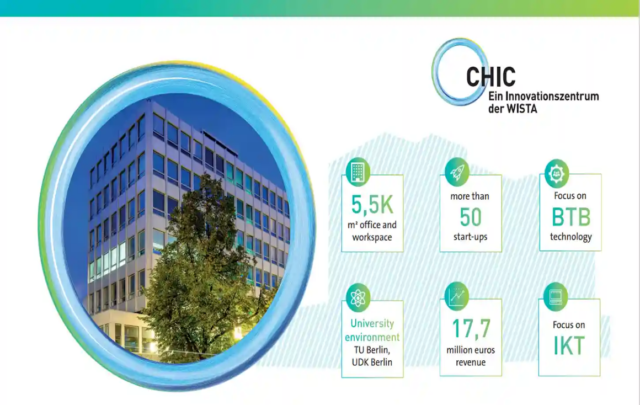
Situation:
A fast-expanding IT firm located in Berlin sought to increase the number of offices from five to fifty. When they first used an unmanaged switch, they encountered:
- Slow file transfers
- Security concerns raised by network visitors
- Not being able to spot bandwidth hogs
Solution:
- They made the move to Ubiquiti UniFi Managed Switches, which offered the following advantages:
- Using VLANs to separate visitor and internal traffic
- Traffic tracking in real time
- Using UniFi Controller for remote management
As a result, there was less downtime during the transfer and faster performance and enhanced security.
Source: UniFi Switch in Startups: Ubiquiti Case Study
2. Second Real-World Example: Japan’s Intelligent Manufacturing
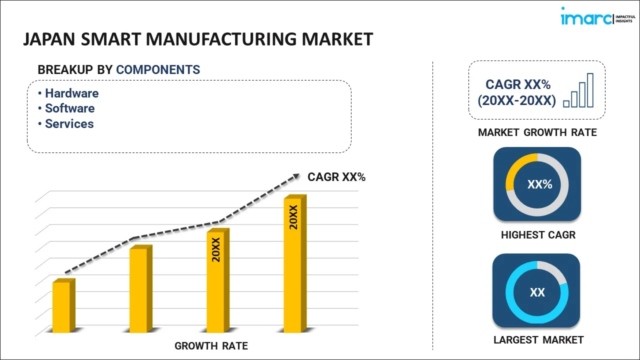
Situation:
Autonomous robots and Internet of Things sensors were placed across the floor of an Osaka smart factory. An uncontrolled switch was unable to:
- Manage the large volume of data.
- Give sensor data priority.
- Assure the security of operations
The Aruba 2930F managed switches with PoE and QoS features were deployed as a solution. This made it possible for:
- Operational and Internet of Things traffic segmentation
- Communication between machines with low latency
- Proactive identification of faults
The outcome was a 20% increase in operational uptime and a 40% decrease in network problems.
Source: Aruba Networks Smart Factory Report is the source.
Cost Benefit Analysis: OpEx vs CapEx
Cost Benefit of Network Switch Managed Vs Unmanaged
| Metric | Managed Switches | Unmanaged Switches |
| Initial Cost | High (e.g., $200–$3000+) | Low (e.g., $20–$100) |
| Maintenance | Requires IT expertise | None |
| Long-Term ROI | High via improved uptime, security | Low |
| Scalability | Easy with stackable options | Limited |
| Support | Vendor SLA, firmware updates | No support |
Verdict
While managed switches are more expensive upfront, the long-term ROI from improved security, how they perform, and scalability makes them perfect for growth-oriented enterprises.
How to Pick the Best Switch (Network Switch Managed Vs Unmanaged) for Your Requirements
The performance, security, and scalability of your network can all be greatly impacted by the sort of network switch you choose, whether it is managed or not. The choice is strategic rather than merely technical. Key considerations and decision-making pathways are included below to assist you in choosing the optimal option given your present circumstances and long-term objectives.
- Establish Your Use Case
Start by determining the switch’s main function in your environment.
| Use Case | Recommended Switch Type |
| Home office or small team with basic connectivity needs | Unmanaged |
| Startup needing performance monitoring and remote access | Managed |
| Enterprise-grade network with multiple departments | Managed |
| Temporary setup (events, expos, pop-ups) | Unmanaged |
| Security-conscious organization handling sensitive data | Managed |
- Expect Growth and Scalability
In the next one to three years, will your network become more sophisticated or larger?
For static networks with little room for growth, unmanaged switches perform admirably.
Because managed switches offer dynamic routing, stacking, and VLANs, they are future-proof and perfect for expanding without completely rebuilding the infrastructure.
Real-World Example:
For simplicity, a ten-person digital marketing business utilized unmanaged switches. They added VoIP phones, video servers, and a media production crew in less than a year. Performance problems resulted from the unmanaged switches’ inability to prioritize calls or segregate traffic. They made the move to Netgear Smart Managed Pro switches, which stabilized performance and increased team productivity by supporting VLANs and QoS.
- Take Security Requirements into Account
Unmanaged switches just don’t cut it if your company deals with critical IP, financial transactions, medical information, or consumer data.
Security features of Network Switch Managed Vs Unmanaged
| Security Feature | Unmanaged | Managed |
| 802.1X Authentication | No | Yes |
| Port Security | No | Yes |
| VLAN Isolation | No | Yes |
| Access Control Lists | No | Yes |
| Logging & Monitoring | No | Yes |
Managed switches offer granular access control, guaranteeing that only authorized users may access certain sections of your network.
- Evaluate performance demands.
Performance is more than simply speed; it also includes consistency and prioritization.
QoS (Quality of Service) in managed switches guarantees that video conferencing, VoIP conversations, and essential apps run smoothly, even during peak loads.
Traffic shaping and bandwidth limiting enable IT teams to avoid bottlenecks.
An architecture business in Chicago reported slowness during cloud-based 3D render uploads and client conversations. Installing Cisco Catalyst 1000 Managed Switches with QoS resulted in consistent performance and a considerable reduction in client-facing latency.
- Technical expertise and IT resources.
Do you possess an IT group or tech-savvy employees that maintain your network?
| Skill Level | Best Fit |
| No IT staff, plug-and-play preference | Unmanaged |
| Small IT team managing remote branches | Smart Managed |
| Full IT department, complex infrastructure | Fully Managed |
Managed switches provide electricity, but they also require installation, configuration, and maintenance. If you’re a lone entrepreneur with no technical knowledge, an unmanaged switch simplifies things.
- Budget considerations.
Frequently, the budget is the deciding factor. Here’s how the costs often add up:
Cost factor of Network Switch Managed Vs Unmanaged
| Cost Factor | Unmanaged | Managed |
| Initial Cost | Low (typically $20–$100) | Medium to High ($150–$1000+) |
| Maintenance | None | Ongoing (updates, monitoring, staff) |
| Total Cost of Ownership | Low | Higher upfront, but better ROI in larger environments |
Consider a “smart managed switch” (e.g., TP-Link JetStream, Netgear ProSAFE) for low-cost VLAN and monitoring.
- Remote Access and Centralised Management
If you manage numerous sites, distributed teams, or a hybrid workforce, you will require:
- Remote monitoring
- Centralized configuration
- Performance Diagnostics
These functions are only supported by managed switches, particularly when combined with cloud controllers such as:
- Cisco Meraki Dashboard
- Unifi Network Controller
- Aruba Central
Decision Flow Chart: Which one of the Switch is Best for You?
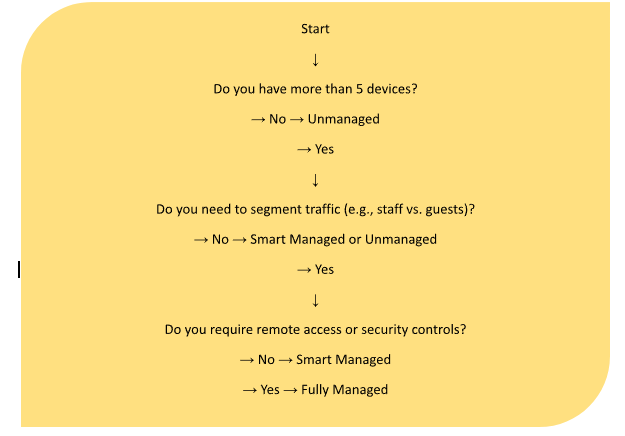
Final Checklist:
| Criteria | Choose Managed If… | Choose Unmanaged If… |
| You need VLANs, QoS, or security | Yes | No |
| You plan to scale your network | Yes | No |
| You have IT support | Yes | No |
| You want plug-and-play simplicity | No | Yes |
| Budget is extremely tight | No | Yes |
Pro Tip:
“The most common networking blunder is failing to plan for the future.” A $100 unmanaged switch may be functional now, but a $300 managed switch might save you millions in downtime and security issues later.”
Final Verdict: Which Will Win in 2025?
Managed switches have more flexibility, how they perform, and security. Most developing firms and organizations find that the advantages exceed the expenses.
But what about households and relatively basic networks? An unmanaged switch still works correctly.
The selection should be based on needs, not on cost. In today’s hyper-connected world, network management is more than a luxury; it’s a need.
Case Studies
Case Study 1: Hospital Network Upgrade in the U.S.

Situation:
A 200-bed hospital in Ohio used unmanaged switches for its outdated system. As telemedicine, digital imaging, and EMRs became more widely used, network concerns arose.
Challenges:
- Unable to prioritize telehealth traffic.
- No authority over rogue devices.
- Recurrent switch overloads and failures.
Upgrade:
The hospital purchased Juniper EX4300 Managed Switches alongside redundancy, PoE, and VLAN support.
Benefits:
- Protects patient records from visitor Wi-Fi.
- Guaranteed real-time performance for telehealth.
- 24/7 monitoring and alerts
The result is 35% quicker retrieve of data for medical imaging and a 50% reduction in IT support issues.
Source: Juniper Networks Healthcare Case Study.
https://www.juniper.net/
Case Study 2: Kenyan Educational Institution

Background:
There were now over 10,000 students enrolled at a Nairobi institution. During video lectures and online tests, their poorly maintained network switches created significant bottlenecks.
Problems:
- Non-academic traffic wasting bandwidth.
- Outages in the network during peak hours
- Absence of centralized oversight
Transformation:
- Managed switches from the Netgear M4300 Series were installed in all departments.
- VLANs for academic vs recreational traffic are an accomplishment.
- Prioritizing QoS for educational platforms
- Remote maintenance and diagnosis
Impact:
Increased professor and student satisfaction and 99.9% uptime during remote learning.
Source: Deployment of Netgear Africa
https://www.netgear.com/
Summary of Network Switch Managed vs Unmanaged
| Feature | Managed Switch | Unmanaged Switch |
| Configuration | Customizable | None |
| Security | High | Basic |
| Monitoring | SNMP, CLI | None |
| VLAN Support | Yes | No |
| Ideal For | Businesses, Schools, Hospitals | Home, Small Offices |
| Cost | Higher | Lower |
| Long-Term ROI | High | Low |
Vendor-Specific Analysis of Network Switch Managed vs Unmanaged
The vendor-specific breakdown that follows includes sample suggestions for both managed and unmanaged switches, along with information on model names, salient features, and optimal use cases is provided below:
Vendor-Specific Recommendations for Unmanaged Switches
These are ideal for plug-and-play installations, small enterprises, and home offices.
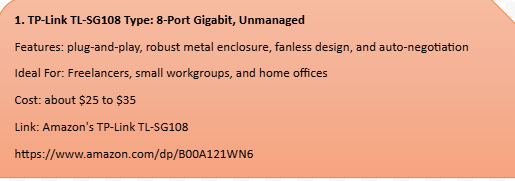
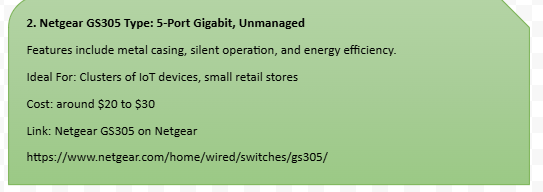
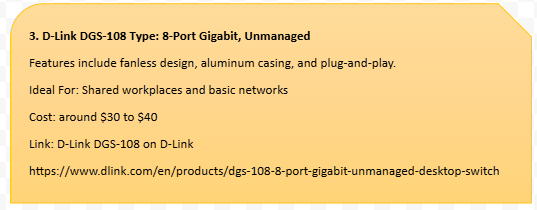
Vendor-Specific Managed Switch Recommendations
These are made for networks that are performance-driven, safe, and scalable.
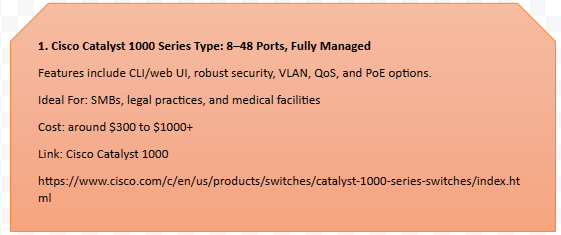
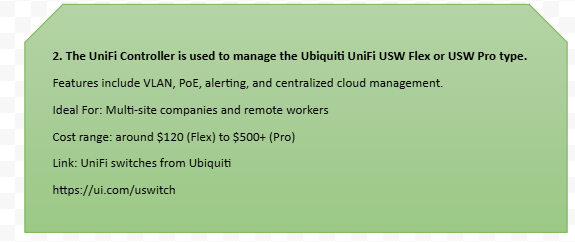
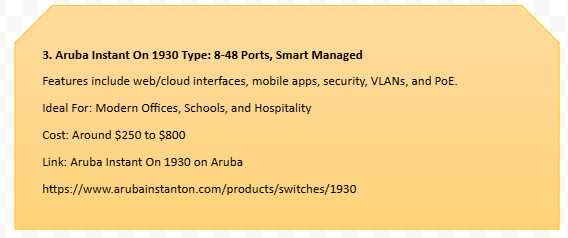
Summary Table of Vendor-Specific Analysis of Network Switch Managed vs Unmanaged
| Brand | Model | Type | Best For | Starting Price |
| TP-Link | TL-SG108 | Unmanaged | Freelancers, home offices | ~$25 |
| Netgear | GS305 | Unmanaged | Retail & IoT setups | ~$20 |
| Cisco | Catalyst 1000 | Fully Managed | Law firms, clinics, SMBs | ~$300 |
| Aruba | Instant On 1930 | Smart Managed | Education, hospitality | ~$250 |
| Ubiquiti | UniFi USW Series | Managed | Remote teams, IT pros | ~$120+ |
| Netgear | GS728TPP Smart Managed Pro | Smart Managed | VoIP-heavy environments | ~$400 |
| MikroTik | CRS328-24P-4S+RM | Layer 3 Managed | Advanced networking setups | ~$400 |
Summary Table of Network Switch Managed vs Unmanaged
| Feature | Managed Switch | Unmanaged Switch |
| Configuration | Customizable | None |
| Security | High | Basic |
| Monitoring | SNMP, CLI | None |
| VLAN Support | Yes | No |
| Ideal For | Businesses, Schools, Hospitals | Home, Small Offices |
| Cost | Higher | Lower |
| Long-Term ROI | High | Low |
Environmental Hybrids: The Best of Both Worlds?
Choosing between managed and unmanaged switches isn’t always the best course of action when it comes to networking; in certain cases, using both is the best option. In order to create adaptable, scalable networks, hybrid environments combine the management and security of managed switches with the ease of use and affordability of unmanaged switches.
This strategy is perfect for startups growing rapidly, businesses in transition, or bigger enterprises looking to save expenses without compromising security or performance in crucial areas.
Real-World Illustrations:
- Chain of Retail Stores Scenario:
Over 200 point-of-sale (POS) locations, five regional warehouses, and a central headquarters (HQ) are all run by a national retail brand.
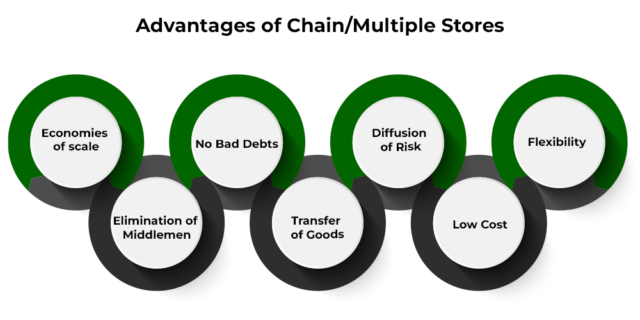
Configuring a Network:
Cisco Catalyst 1000 controlled switches are used in headquarters and warehouses to enable centralized network monitoring, traffic prioritization (for VoIP), and VLANs.
Retail Stores:
Every POS store should use TP-Link TL-SG105 unmanaged switches. These sites don’t require sophisticated security or remote control; they just require basic device connectivity (POS terminals, receipt printers, tablets).
The Reason It Works:
- Cost savings per location: Unmanaged switches cost about $20 to $30 per store.
- At key areas, traffic shaping and centralized security are still in place.
- Without having to worry about micromanaging low-risk store networks, IT teams can concentrate their attention on mission-critical nodes.
Impact on Business:
“We maintained complete control over critical systems while reducing our network upgrade cost by 30% by segmenting where we invested in managed switches.” – Director of IT, Private Retail Chain
- Healthcare Provider Network Scenario
A regional healthcare organization runs a number of small clinics in suburban and rural locations in addition to a central data center.

Configuring a Network:
For enhanced security (802.1X authentication, ACLs), network segmentation, and PoE for wireless access points and IP surveillance, use Aruba 2930F managed switches in data centers and main hospitals.
Small Clinics & Mobile Testing Units:
In small areas with little IT assistance, connect printers, simple workstations, and routers using Netgear GS308 unmanaged switches.
Benefits:
- Lessens the requirement for IT personnel on-site in smaller settings.
- Stops excessive expenditure on things that are unnecessary in low-risk settings.
- Maintains HIPAA compliance by using core systems that are securely controlled.
- Office Networks: Division by Department
Different departments may have varying connectivity requirements in large office complexes. The IT staff may make intelligent resource allocations using a hybrid configuration.

An example of a setup:
Departments of finance and human resources: Use managed switches to implement port-level security and VLANs for sensitive data.
Marketing and Design Teams: When fewer security controls are required, use unmanaged switches for quick and easy internal cooperation.
In less sensitive locations, this simplifies deployment while offering focused control.
Decision Matrix: When to Use Hybrid Network System Managed vs Unmanaged
| Criteria | Use Managed Switch | Use Unmanaged Switch |
| High-security zone (e.g., finance, health records) | Yes | No |
| Low-risk area (e.g., POS terminal, reception desk) | Not required | Yes |
| Remote management required | Yes | No |
| Minimal IT support available | Not ideal | Yes |
| Advanced features needed (QoS, VLANs) | Yes | No |
The Best Methods for Hybrid Settings of Network System Managed vs Unmanaged
- Divide Up Your Network Wisely:
To divide departments or tasks, use VLANs on controlled switches.
- Put Critical Infrastructure First:
In situations where uptime or sensitive data flow are essential, always utilize managed switches.
- Document the Architecture:
To keep things clear and prevent misunderstanding during troubleshooting, map out the locations of managed and unmanaged switches.
- Establish Gradual Upgrade Paths:
In low-risk locations, temporarily use unmanaged switches with the opportunity to replace them later if necessary.
- Centralize Monitoring with Core Managed Switches:
Make sure that all essential pathways pass through a managed switch that can provide alerts and diagnostics, even if edge devices are not managed.
The Final Word
A hybrid environment is a strategic benefit rather than a compromise. Performance, security, and cost-effectiveness may all be balanced throughout your network by strategically placing switches. This methodology allows for sensible scalability and incremental expenditures for expanding organizations without over-engineering or under-protecting any infrastructure components.
Conclusion: Selecting the Appropriate Network Switch Managed vs Unmanaged
Understanding the difference between the unmanaged and managed switches is essential since there isn’t a single solution that works for the networking sector.
If you’re running a simple, modest setup and cost-effectiveness and usability are your top priorities, unmanaged switches are perfect. They are plug-and-play, low-cost, and perfect for low-risk applications including basic point-of-sale terminals, home offices, and temporary deployments.
However, when your network needs security, optimization of performance, monitoring, and scalability, managed switches provide you the information and control you desire. For companies that depend on uninterrupted connection and uptime, they enable IT staff to prioritize services like VoIP, secure endpoints, segregate traffic using VLANs, and troubleshoot proactively.
Remember the hybrid approach, which is a clever compromise in which you strategically employ both kinds of switches. It is adapted, affordable, and scalable to practical requirements.
So, how do you make a choice on network switch managed vs unmanaged?
Consider this:
- Is sensitive data handled by your network?
- Do you have to give particular kinds of traffic priority?
- Over time, will your network expand or evolve?
- Do you require remote management and monitoring?
If any of these responses are “yes,” it’s time to think about managed switches, or a careful combination of the two.
Lastly, consider what your network may want in the future, but start with what it requires now. Making the correct switch choice today may save you thousands of dollars in future upgrades and hours of troubleshooting.
Having trouble choosing the correct switch? To help you make an easy choice, go through this blog for vendor-specific suggestions, a printable comparison guide, and professional advice.
Allow your network to be a resource rather than a hindrance.
The Frequently Asked Questions (FAQ) Section
- Should I use an unmanaged or managed switch?
The size, complexity, and control requirements of your network will determine this.
If you want straightforward plug-and-play connection, choose an unmanaged switch; these are perfect for low-risk settings, small workplaces, and home networks.
If you want capabilities like VLANs, QoS, traffic monitoring, remote configuration, or enhanced security—all of which are critical for medium-to-large enterprises, VoIP, or situations where data is sensitive—use a managed switch.
Pro Tip: A lot of companies utilize both—unmanaged switches at less important nodes and managed switches at key sites (for more information, read our Hybrid Environment section).
2. What qualities distinguish a managed switch?
Managed switches provide:
- Support for network segmentation via VLAN
- Quality of Service (QoS) for giving priority to important traffic (like VoIP)
- Remote administration with web GUI, SNMP, or CLI
- Security measures such as ACLs and 802.1X authentication
- Port tracking and analysis
- Logging and traffic analytics
- Configuration backup and firmware updates
Perfect for: Finance departments, healthcare systems, enterprise networks, educational institutions, and expanding small and medium businesses.
3.What are the characteristics an unmanaged switch?
Unmanaged switches provide:
- Plug-and-play ease of use
- Automatic speed and duplex negotiating
- No software setup or configuration is required.
- Less expensive and less upkeep
- Absence of remote management, QoS, VLAN, and security features
Perfect for: IP cameras that don’t require monitoring or prioritizing, standalone printers, small retail stores, and home users.
4. In the same network, is it possible to combine managed and unmanaged switches?
Indeed! A hybrid switch environment is what this is called.
For instance, a company may install unmanaged switches at satellite offices or departments with little requirements and utilize a managed switch in the corporate office to regulate traffic and security. This method simplifies low-risk regions and saves money without compromising security or core functionality.
See our section on Hybrid Environments: The Best of Both Worlds for additional information.
5. Is IT knowledge necessary for managed switches?
In general, yes, however a lot of contemporary managed switches (such as Aruba Instant On or Ubiquiti UniFi) include configuration-friendly mobile applications and user-friendly interfaces. More complex configurations (such CLI, SNMP, and VLAN tagging) require some understanding of networking.
For convenience, if your company does not have in-house IT, think about using a cloud-managed switch solution.
6. Will my internet speed be slowed by an unmanaged switch?
Usually not, provided that:
- You’re not using more bandwidth than the switch can handle.
- Devices aren’t overloading a network with traffic, such as file servers or security cameras.
7. Are switches that are managed more secure?
Of course. Support for managed switches:
- VLANs (for traffic isolation)
- Security of ports
- Lists of Access Control (ACLs)
- Port-based authentication using 802.1X
- SNMP monitoring to identify anomalies
These are absent from unmanaged switches, which makes them inappropriate for settings that handle sensitive data.
8. Is a managed changeover worth the extra money?
If your network:
- Is expanding
- Enables video conferencing, VoIP, and remote teams
- Requires traffic separation, such as between internal systems and guest Wi-Fi.
- Manages regulated or sensitive data (e.g., PCI-DSS, HIPAA)
In that case, investing in uptime, performance, and security is what a managed switch costs.



